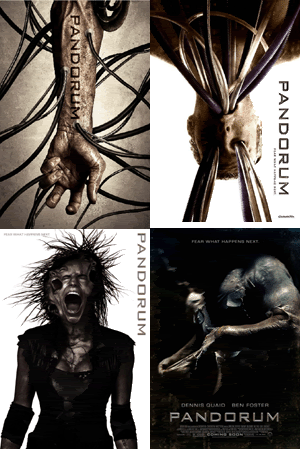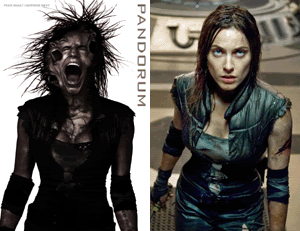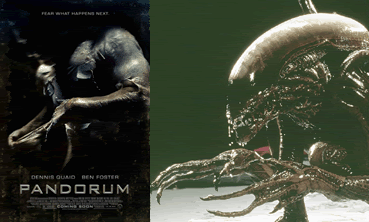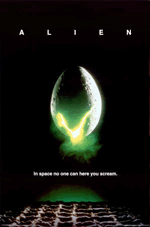2009 had Quaid starring in Horsemen, G.I. Joe: The Rise of Cobra, and Pandorum, and while I haven't seen Horsemen, I can vouch for G.I. Joe being 100 % rabbit rubbish, and proof-positive Stephen Sommers has creatively devolved since his Mummy films. Van Helsing is a brilliant pulp culture fusion compared to the shrill, garish idiocy that is G.I. Joe.

Pandorum was marketed using a slick graphics campaign built around the concept of great big tubes of fluids coming outside of an arm, a head’s orifices, and a woman with a mutating head. There was also a design that resembled H.R. Giger’s Alien creature, although those familiar with the film will recognize it’s a carefully lit image of a man emerging from the tube where he’s spent a long period in suspended animation.
One aspect director and co-writer Christian Alvart (Antibodies / Antikörper) wanted to demystify was in fact the graceful reawakening of crewmen, as seen in Alien (1979). Alvart’s concept was more invasive, and may be more close to the kind of needs a body requires if it’s to be preserved like a pickle in a jar with juices to keep it alive.
When the first crewman, Bower, emerges from his tube, his skin is covered in an exo-skin that shriveled and white, and the first order of business it to rip out several large tubes that have been buried in his arm. Much like the ripping out of electrodes at the end of Resident Evil (2002), it’s a nasty moment that makes it clear Pandorum isn’t going to be an elegant foray into phallic mayhem the way Ridley Scott directed Alien.
Of the aforementioned posters, the arm is the closest inference of the film’s tone, whereas the multitude of tubes seemingly slithering though the head makes no sense.
It’s striking, but what does it mean?

The madwoman is a fusion of two things: the madness of pandorum – uber-stress from long space travel – that includes delusions, paranoia, and thoughts of murder; and the form of biologist Nadia (played German hottie Antje Traue).

The Giger Alien riff is more clever, but again, the art doesn’t address the film’s more visceral villains – reptillian cannibals – and it’s symptomatic of the film’s producers (which, coincidentally, include the makers of the Resident Evil franchise) perhaps not being sure as to how Pandorum’s fairly dense story could be distilled into one significant image.

The cracked egg that appeared in the original Alien campaign inferred the physical and metaphorical birth of blank-faced, primal hunger, an image that was used in Scott’s own trailer, capped with the immortal line “In space no one can hear you scream.” There was mystery, tension, and intrigue; with Pandorum, the graphic artists perhaps didn’t quite understand Alvart’s film – and that’s apparently what audiences shared during the film’s theatrical release.

As my DVD review attempts to examine, there is much to admire and be frustrated with, because some unfortunate decisions – mostly assuming style should supersede coherence – will probably ensure Pandorum will never live up to its promise, since the picture is permanently locked.

Michl Britsch’s score, however, certainly does hit Alvart's aspirations. It’s a weird melange of orchestral, industrial and rock that shape-shifts every few seconds into something beautifully nasty, and is worth snapping up from MovieScore Media. (My review will appear in a forthcoming issue of Rue Morgue magazine.)

Dennis Quaid, interestingly, was Alvart’s top choice as star, and that stems from the director’s huge affection for Quaid’s 1987 film Innerspace, which has grown into a favourite cult film that fused elements of slapstick comedy, science-fiction, and a nostalgia for classic sci-fi films.
It’s perhaps unsurprising that Jerry Goldsmith’s music score is equally beloved by fans, and tangentially part of Quaid’s recent film wave, La-La Land Records has released the complete score on a beautifully mastered CD. The original Geffen LP contained just a few cues (plus dated pop songs), whereas the new limited release album features 78 mins. of goodness.
Goldsmith scored both Outland and Alien, two films that exploited the fear of being isolated in spaceship, or in a restrictive environment, and like Outland, Dark Castle’s Whiteout takes the Outland template and repositions it to the chilly locale of Antarctica.

Whiteout is an atypical Dark Castle production, and much like Pandorum, it was sold using a rather deceptive ad campaign. Pandorum’s trailer infers the cannibalistic creatures are what the surviving humans will quickly become (not true), whereas the Whiteout trailer makes it seem as though there's a Presence, or a Force, or a Being that the sheriff discovers in a submerged Soviet plane lost during the Cold War.
Not so.
Based on the graphic novel by Steve Lieber and Greg Rucka, Whiteout is a fairly straightforward whodunnit that happens to be set at the bottom of the world. Why Dark Castle, makers of gory horror shockers (The Hills Run Red) chose a whodunnit is, uhm, a mystery, since the film is essentially ‘an xtreme whodunnit’ with lots of cold air.
Is it a dud?
Nope, but the lack of distinctive extras – paltry on the DVD, and some exclusive interactive material on the Blu-ray – leaves one to believe the film was hurried to home video.
The biggest shock: Kate Beckinsale is quite good, and she grounds the movie with an earnest performance.
Not surprising: Dominic Sena’s wonky use of flashbacks that assume you may have less short-term memory capabilities than a goldfish.
To goldfish, that’s just rude.
- MRH







0 comments:
Post a Comment